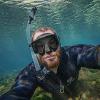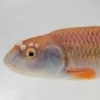Florida FSU Tates Hell 2013
#63
 Guest_Dustin_*
Guest_Dustin_*
Posted 23 January 2014 - 08:37 AM
I should restate my comment. Traditionally pygmy sunfishes are not found in areas devoid of vegetation, leaf litter and detritus. They certainly can be found associated with cover such as stones and woody debris, but typically only where their preferred habitat either overlaps or is in close proximity.
My comment was more geared towards Erica's notion that she should place stones in her pygmy sunfish tank.
#64
 Guest_trygon_*
Guest_trygon_*
Posted 23 January 2014 - 09:05 AM
#65
 Guest_Erica Lyons_*
Guest_Erica Lyons_*
Posted 23 January 2014 - 09:16 AM
Here's video from back when I had a rock in the tank:
Those are elassoma gilberti, ancestors collected near Tallahassee, captive born in my tank.
#66
 Guest_Casper_*
Guest_Casper_*
Posted 23 January 2014 - 04:07 PM
Ain't many rocks down in the panhandle. Mostly mined limestone for roadwork. An odd thing about Fanning Springs is i recall it being much more lush years ago. I have seen this occur at other Florida springs as well, human activity, if unchecked, will trample near all the vegetation at springs leaving them devoid of green and leaving only sand, limestone and bankside tree roots. At Fanning i remember lush waving beds of green val in the spring head depths, my first time to see a Bowfin lurking within, and well beyond human feet, so another environmental factor is probably at play here.
When turning the stones Isaac and i would often find 2 Pygmys, perhaps nesting or breeding. Surely they sought out the stones as cover because many of their giant kin where swimming above eager for a tasty blue flecked treat. There was some vegetation closer to the bank but not a lot and none where we "exposed" the Pygmys, believe it or not. Fist sized chunks of limestone make for suitable aquaria decor. Or a chunk of gnarrly wood. Cute little fish.
#67

Posted 23 January 2014 - 04:34 PM

Here's a photo of the E. gilberti habitat that Casper and I snorkeled. It's not a great photo (I was trying to photograph the redbreast, not the habitat), but it does show the algae-covered rocks the pygmy sunfish were living under. I found probably 20-30 individuals by slowly lifting the rocks and looking underneath. I never saw any in the aquatic plants shown in the background of the photo. Most of the aquatic plants at this site were at the surface, and in my experience pygmy sunfish are usually found in cover near the bottom. This site didn't offer much bottom cover other than the rocks. At other sites I have observed them near the bottom in dense aquatic vegetation or leaf litter/detritus. So, I think that Dustin's statement holds true the majority of the time, but there are usually some exceptions.
#68
 Guest_gerald_*
Guest_gerald_*
Posted 23 January 2014 - 05:03 PM
#69
 Guest_Casper_*
Guest_Casper_*
Posted 23 January 2014 - 05:46 PM
#70
 Guest_Stickbow_*
Guest_Stickbow_*
Posted 26 June 2014 - 09:30 PM
Also - is McBride Slough public or private?
#73
 Guest_Casper_*
Guest_Casper_*
Posted 26 June 2014 - 11:37 PM
Americus... Near Jimmy Carter's Gooberville. Not too far from Andersonville and the life giving miracle of Providence Spring.
You should visit the Gates to Hell, get in one of those electric canoes. Some clues on the 2013 postings or check at Harry's, downtown Carrabelle.
Be sure and do the Wakula jungle cruise but stay in the boat.
You can slither slide upstream of McBride and see a near virgin spring. Caution as you are entering amongst gun toting members of a hunting club's beer drinking central respite. Stay low.
Tell us of your return.
#74
 Guest_mikez_*
Guest_mikez_*
Posted 27 June 2014 - 06:07 AM
I'm led to believe they're low pH, low mineral only type critters. Turned me off the idea of keeping any since I can't easily recreate those conditions in my treated town water.
#75

Posted 27 June 2014 - 06:50 AM
#77
 Guest_gerald_*
Guest_gerald_*
Posted 27 June 2014 - 09:43 AM
Since this got bumped, I read the part of pygmy sunfish in the rocks and had a question; what would be the pH and harness, roughly, is such environment? I'm led to believe they're low pH, low mineral only type critters. Turned me off the idea of keeping any since I can't easily recreate those conditions in my treated town water.
#78
 Guest_Stickbow_*
Guest_Stickbow_*
Posted 27 June 2014 - 01:39 PM
I've done the jungle cruise a bunch o' times - even done the nearly extinct glass bottom boat ride several times - have seen it change over time.
Have any of you snorkeled and photographed on the Ichetucknee river? Way overcrowded in summer, but the rest of the year it's really nice, with HUGE fish and water clearer than the air. It's fun to actually scuba vs. snorkel.
#79
 Guest_Casper_*
Guest_Casper_*
Posted 27 June 2014 - 03:15 PM
I was scuba certified there, well just before, at Jennie Springs i recall with 30 years. Anyway i have been back and yes it is CRAZY in summer... not good for a snorkeler. Beer drunks, canoe head strikes, zero visibility. Best do in the off season. Try the Santa Fe River.
Yep the glass bottom boat tours are near over. It's still ok to jump off the high platform or snorkel the shallows or downstream at the Canoe Hidaway or the other highway crossing. Gator beware though. McBride is nice, easy, diverse and convenient.
Treat your wife to a meal at the Wakula Lodge.
#80
 Guest_Stickbow_*
Guest_Stickbow_*
Posted 29 June 2014 - 10:32 PM
Reply to this topic
0 user(s) are reading this topic
0 members, 0 guests, 0 anonymous users










